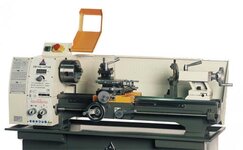Randy, mine is nothing special, it's a Chester DB10VS 10x21.5 ( Chinese clone )
When I went out to buy a lathe, I was a bit daunted by the change gears and would have bought the fixed gearbox version if they had one in stock.
Now that I now a little more about it, I can honestly say that that was the best thing that could have happened. If I'm not mistaken, then a lathe with loose gears is cheaper than the fixed version too.
One of my favourite books is Martin Cleeves' 'Screwcutting in the Lathe'
Number 3 in the Workshop Practice Series. This book not only shows how to cut threads, but also deeply explains how to set the gears to get the required pitch. Not just the standard ones printed on the front of the machine. I couldn't remember where I put the book till now so got my gear setting the hard way:redface:
In the book he references a Prof D H Chaddock who calculated how many possible thread combinations there are with a full set of changable gears.
Quote; According to Prof D H Chaddock, 20 change gears can be set in 380 two gear combinations, 29 070 four gear combinations and 775 200 six gear combinations, a total of 804 650 ways. Allowing for 10 000 or so identical ratios arising from the same gears in a different order, the total possible ratios from 20 gears in 2,4 and 6 gear combinations is about three quarters of a million, but not if they are locked up in a gearbox. Instead of increasing the versatility of a lathe, a selective screwcutting gearbox reduces it.
End Quote
Even a lathe that is metric but has gears that can be changed around, can cut many more imperial threads than a fixed gear imperial lathe

